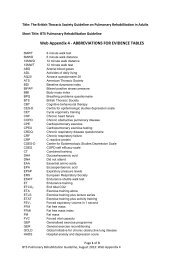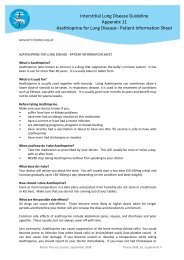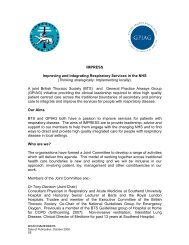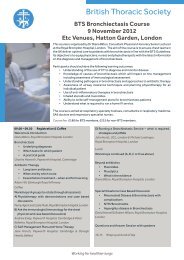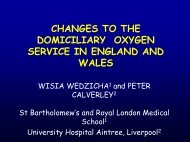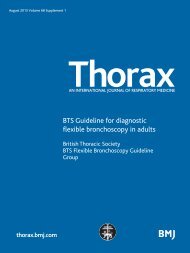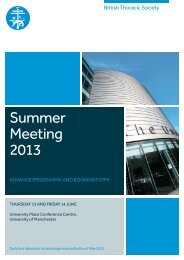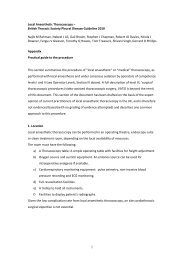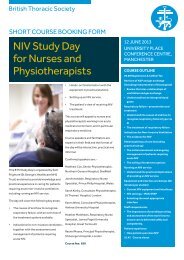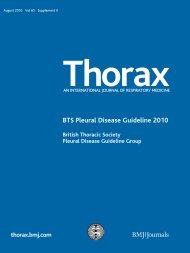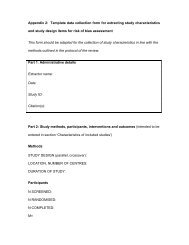Guidelines for the management of community ... - Brit Thoracic
Guidelines for the management of community ... - Brit Thoracic
Guidelines for the management of community ... - Brit Thoracic
Create successful ePaper yourself
Turn your PDF publications into a flip-book with our unique Google optimized e-Paper software.
BTS guidelines<br />
APPENDIX 1 CHECKLIST USED BY REVIEWERS FOR<br />
APPRAISING STUDIES<br />
Study: ____________________________ Reviewer: ____________________<br />
Please complete section 1 first. If study OK, complete one <strong>of</strong> sections 2a–d as<br />
appropriate.<br />
1. General: is <strong>the</strong> study relevant to our question?<br />
% Were <strong>the</strong> patients studied similar (in age, gender, disease severity …) to target<br />
patients?<br />
% Were <strong>the</strong> outcome measures <strong>of</strong> interest to us and our patients?<br />
% Was <strong>the</strong> clinical setting (primary care, intensive care …) similar to our setting?<br />
% Was <strong>the</strong> study carried out in a healthcare system similar to ours?<br />
% Is <strong>the</strong> study design recognisable and appropriate, with clear methods described?<br />
% Is <strong>the</strong> study recent enough to take account <strong>of</strong> any important advances?<br />
% If negative, was this study large enough to provide useful in<strong>for</strong>mation?<br />
APPENDIX 2 ADDITIONAL CHECKLIST USED FOR APPRAISING<br />
STUDIES TO INFORM PNEUMONIA AETIOLOGY<br />
Absolute requirements:<br />
c Is this an original report?<br />
c Were patients with CAP separately identified?<br />
c Was <strong>the</strong> study designed to assess CAP aetiology?<br />
c Was <strong>the</strong> patient sample representative (eg, sufficient numbers, consecutive<br />
cases, exclusions clearly defined)?<br />
c Was <strong>the</strong> study <strong>of</strong> sufficient duration to exclude seasonal bias?<br />
Data qualification:<br />
c Is <strong>the</strong> geographical area clear and relevant?<br />
c Is <strong>the</strong> patient age group defined?<br />
c Are microbial investigations clearly defined?<br />
c Was <strong>the</strong> investigation biased towards a specific pathogen?<br />
c Is <strong>the</strong> setting <strong>community</strong>, hospital, intensive care or a combination?<br />
2a. Studies <strong>of</strong> cause and effect (randomised trial <strong>of</strong> treatment)<br />
% Was assignment <strong>of</strong> patients to treatment truly randomised?<br />
% Was <strong>the</strong> planned <strong>the</strong>rapy concealed from those recruiting patients be<strong>for</strong>e<br />
enrolment?<br />
% Were all patients who entered <strong>the</strong> study accounted <strong>for</strong>?<br />
% Were patients analysed in <strong>the</strong> groups to which <strong>the</strong>y were initially randomised?<br />
% Were patients and doctors blind to <strong>the</strong> <strong>the</strong>rapy given?<br />
% Were groups treated <strong>the</strong> same way, apart from <strong>the</strong> <strong>the</strong>rapy?<br />
% Were <strong>the</strong> groups similar at <strong>the</strong> start <strong>of</strong> <strong>the</strong> trial?<br />
2b. Studies <strong>of</strong> aetiology (case-control study <strong>of</strong> a harmful agent)<br />
% Were <strong>the</strong>re two groups <strong>of</strong> cases, similar except <strong>for</strong> exposure to harmful agent?<br />
% Was occurrence <strong>of</strong> <strong>the</strong> outcome measured in <strong>the</strong> same way <strong>for</strong> both groups?<br />
% Were enough patients followed up <strong>for</strong> long enough <strong>for</strong> <strong>the</strong> outcome to develop?<br />
% Did exposure clearly precede <strong>the</strong> outcome?<br />
% Was <strong>the</strong>re a dose-response gradient?<br />
% Was <strong>the</strong>re a re-challenge, or improvement after <strong>the</strong> drug stopped?<br />
% Does <strong>the</strong> association make biological sense?<br />
2c. Studies <strong>of</strong> diagnosis (evaluation <strong>of</strong> clinical findings or tests)<br />
% Was <strong>the</strong> finding or result compared with a 24 carat gold standard <strong>for</strong> diagnosis?<br />
% Was <strong>the</strong> finding or result determined blind to <strong>the</strong> gold standard?<br />
% Was <strong>the</strong> gold standard determined blind to <strong>the</strong> finding or test result?<br />
% Was <strong>the</strong> gold standard determined in all cases, not just those with an abnormal<br />
result?<br />
2d. Studies <strong>of</strong> prognosis, prognostic index (cohort studies)<br />
% Was a defined sample <strong>of</strong> patients assembled at an early stage <strong>of</strong> <strong>the</strong> disease?<br />
% Were patients followed up long enough <strong>for</strong> <strong>the</strong> outcome to develop?<br />
% Was <strong>the</strong> outcome clearly defined, objective and assessed blind to exposure in all<br />
cases?<br />
% Was <strong>the</strong> per<strong>for</strong>mance <strong>of</strong> any prognostic index tested on a fresh set <strong>of</strong> cases?<br />
3. Comments<br />
iii54<br />
Thorax 2009;64(Suppl III):iii1–iii55. doi:10.1136/thx.2009.121434



